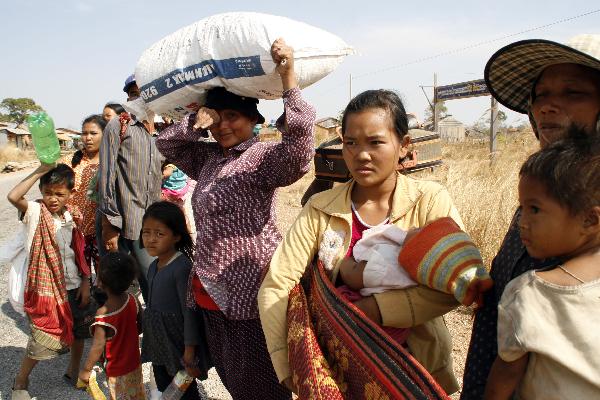By John Sexton
China.org.cn,
February 9, 2011
China.org.cn,
February 9, 2011
At least eight Cambodians and two Thais have died in four days of border clashes around the ruins of an 11th century Hindu temple. Thailand contests a 1962 World Court ruling that the Preah Vihear site is on Cambodian territory. But the recent flare-up has more to do with Thailand's polarized domestic politics than disputed territory.
 |
Cambodian villagers are evacuated from the border near the Preah Vihear temple in Preah Vihear province, some 500 km northwest of Phnom Penh, Cambodia, on Feb. 5, 2011.[Xinhua]
|
The border clash was deliberately provoked by the Thai Patriot Network (TPN), a splinter group from the extreme right wing People's Alliance for Democracy (PAD). Mass mobilizations by the mainly middle-class Yellow Shirts of the PAD have overthrown two governments in the last 5 years.
In December, seven TPN supporters, including an MP from Thailand's ruling Democratic Party, were arrested after walking into Cambodian territory. A Phnom Penh court later jailed TPN leader Veera Somkwamit and his secretary for spying, but released the other five. The Yellow Shirts and their allies from the TPN and the Santi Asoke Buddhist sect brought their supporters back onto the streets of Bangkok to demand a tough response from the Thai government.
The rightists aim to derail elections that Prime Minister Abhisit Vejjajiva promised to call before the end of 2011. Abhisit made the promise after using the army to disperse demonstrators from Thailand's Red Shirt opposition, the United Front for Democracy Against Dictatorship (UDD), who had demanded immediate elections. Nearly 100 protesters were killed last May, including UDD security chief Khattiya Sawasdiphol who was shot in the head by a sniper while being interviewed by the New York Times.
Abhisit's fundamental problem is that he lacks popular legitimacy, having come to power in a 2008 parliamentary coup following weeks of Yellow Shirt demonstrations that culminated in the occupation of Bangkok's main airport. And he faces problematic electoral arithmetic. Each time voters have been called on in recent years, they have delivered a majority to parties supported by the Red Shirt coalition.
Most of the mainly working class Red Shirts support the former Prime Minister Thaksin Shinawatra, who introduced popular health and welfare reforms during his period in office. But the Yellow Shirts, who are drawn from the business class and monarchists, see the working class and rural poor as dupes of the exiled billionaire, unqualified to vote. Their determination to prevent another Red Shirt election victory has driven them to adopt a high-risk strategy that may result in war with Cambodia.
Some among the fractious right wing alliance have now turned against Abhisit and are calling for to be replaced, by what means they have not specified. Yellow Shirt leader Sondhi Limthongkul has gone so far as to denounce Abhisit as a traitor.
It is possible that the remobilization of the Yellow Shirts will help Abhisit survive an election by presenting himself as a moderate centrist. He has tried to win over some Red Shirt supporters by extending welfare measures. An Abhisit victory would, of course, be the favored result for the international community, who see him as an ideal business-friendly politician, lacking only the benediction of the electorate.
But with all political forces in Thailand fragmented, society polarized between rich and poor, and the exiled Thaksin still calling many of the shots, prospects of ending the turmoil seem some way off and the threat to peace remains real.
Opinion articles reflect the views of their authors, not necessarily those of China.org.cn.

No comments:
Post a Comment